All You Need to Know About Cats in Heat

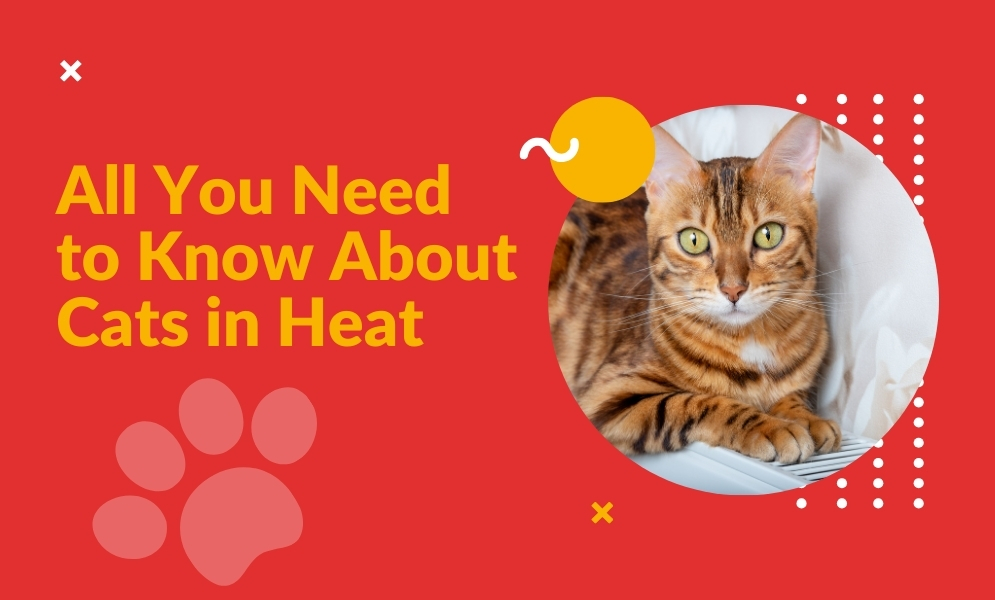
Is your cat acting a bit strange recently? Is she acting restless, meowing a lot, and seeking more attention from you than usual? Then, if she has not been spayed already, chances are she might be in heat. The heat cycle is a natural biological process that occurs in sexually mature, intact (non-spayed) female cats.
During this period, your cat’s body gets ready for potential mating and reproduction and consequently goes through a lot of hormonal changes. She may also make some desperate attempts to escape. As a result, it can be quite a challenging time for both the cat and you.
So, we are here to help. In this article, we will talk about this natural process in detail, from the signs and symptoms and common myths and misconceptions about cats in heat to proper cat care during this time. It will help you take better care of your cat and make informed decisions about her well-being. Let’s get started.
Common Myths and Misconceptions About Cats in Heat
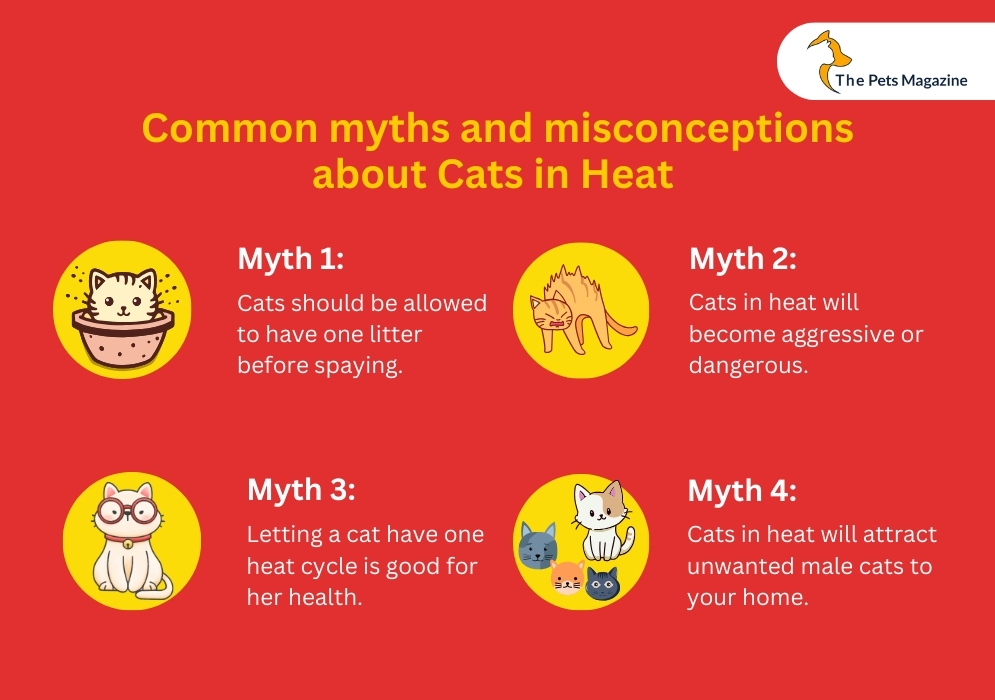
Before we start discussing cats in heat in detail, let’s first take a quick look at some of the common myths and misconceptions surrounding this natural process. It’s important to know about these myths and separate facts from fiction, as it will help in ensuring you’re providing the best care for your feline friend. Here are some common myths and the truth behind them:
Myth 1:
Cats Should be Allowed to Have One Litter Before Spaying.
Fact:
There is no medical or behavioral benefit to allowing your cat to have a litter before spaying. In fact, spaying your cat before her first heat cycle can help prevent specific health issues.
Myth 2:
Cats in Heat will Become Aggressive or Dangerous.
Fact:
Yes, cats in heat may show aggressive behavior due to fluctuations in their hormone level. Cats may show aggressiveness through increased vocalization such as loud yowls and growls, their play turning into fight and other behaviors like biting.
So, if you are wondering “why does my cat bite me,” it may be because she is experiencing heat and feeling uncomfortable. However, if a cat’s behavior becomes disruptive or problematic, it’s best to consult your veterinarian.
Myth 3:
Letting a Cat Have One Heat Cycle is Good for Her Health.
Fact:
There is no medical evidence that suggests allowing your cat to experience a heat cycle will be beneficial for them. In fact, according to experts, spaying your cat before her first heat cycle can help prevent certain reproductive system issues and cancers.
Myth 4:
Cats in Heat Will Attract Unwanted Male Cats to Your Home.
Fact:
While it is true that male cats may be attracted to the pheromones released by a female cat in heat, this is not a guarantee. Proper confinement and managing your cat during her heat cycle can help mitigate this issue.
Knowing the facts instead of the myths will help you make informed decisions about your cat’s health and well-being, ensuring that you provide the best cat care possible.
What Are The Signs and Symptoms of a Cat in Heat?
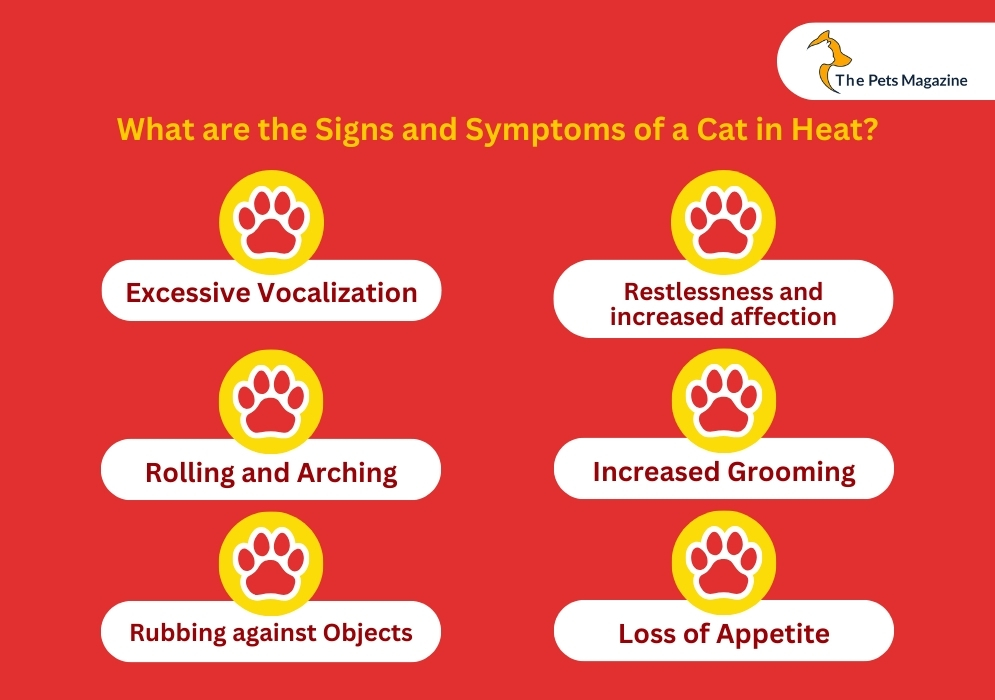
Along with having a clear idea about the facts and misconceptions surrounding this natural process, you also need to know the symptoms that indicate when a cat is in heat. However, that is a relatively easy thing to do. Because you see, when your cat enters her heat cycle, you’ll likely notice a range of behavioral and physical changes. These signs can be quite pronounced and may include:
- Excessive vocalization: This is one of the most noticeable signs of cats in heat. Your otherwise quiet cat may become more vocal, meowing persistently and loudly, especially when seeking attention or trying to attract potential mates. As a first-time cat parent, understanding your cat’s behavior should be your priority.
- Restlessness and increased affection: She may appear restless or unable to settle down. You may see them jumping on the furniture, pacing around the house, and seeking more attention and affection from you or other household members.
- Rolling and arching: You may observe your cat rolling on the ground and exposing her belly to you. She may also arch her back, lower her front legs, and raise her rear, sometimes treading with her hind legs. Both behaviors are classic mating postures.
- Increased grooming: Your cat may groom herself more frequently, particularly around her genital area. Additionally, the area around her genitals may become swollen.
- Rubbing against objects: She may rub her face and body against furniture, walls, or other objects, leaving behind pheromones to attract potential mates.
- Loss of appetite: During the heat cycle, your cat’s appetite may temporarily decrease or become irregular. However, also note there can be other reasons too for cat not eating much but acting normal.
These signs can vary in intensity and duration, depending on your cat’s individual circumstances and her age.
Heat Cycles in Female Cats: Common Concerns
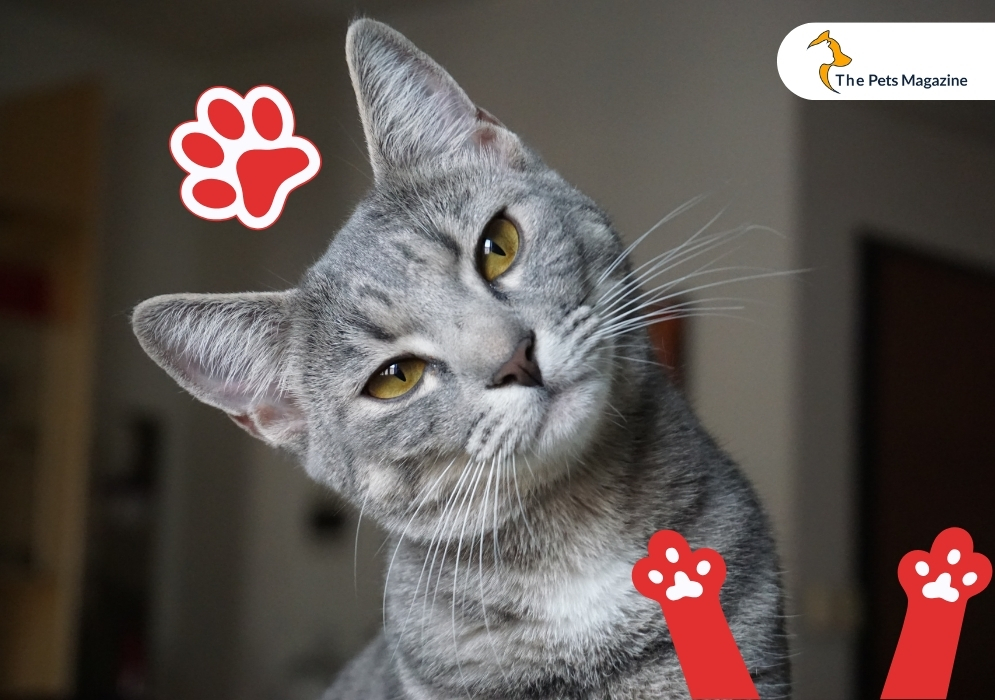
We know that first-time cat parents also have many questions about cats in heat, such as whether cats bleed, when they go in heat and how long is a cat in heat. We have addressed some of these common questions that first-time cat parents have in this section.
How Long are Cats in Heat?
One of the most common questions that first-time cat parents have regarding their female cats in heat is how long and when do cats go in heat. However, there is no specific answer as the frequency of heat cycles in female cats can vary depending on several factors.
This includes age, breed, and environmental conditions. But here’s a general overview of how often cats go in heat:
Kittens: Female kittens typically experience their first heat cycle around six to ten months, although some may start as early as four months old.
Adult cats: Once a cat reaches sexual maturity, she will typically go into heat every two to three weeks during the breeding season, which typically lasts from early spring to late fall. They also go into heat well into their senior
It’s important to note that indoor cats may experience more frequent heat cycles than outdoor cats, as they are not exposed to the seasonal changes that can influence the breeding season. Similarly, cats living in warmer regions experience heat cycles all year round compared to cats in colder weather.
Do Cats Bleed When in Heat?
Another common concern cat parents have is whether cats bleed during their heat cycle. The answer is No, cats don’t bleed like humans or female dogs. This is because they reabsorb the uterine lining instead of shedding it.
Cats do so because they are induced ovulators meaning they don’t ovulate or release an egg spontaneously. The act of mating triggers the process of ovulation in female cats. Consequently, bleeding or bloody discharge is rare occurrence for cats in heat.
Do Female Cats Spray When in Heat?
First time owners of female cats should know that it is common for female cats in heat to engage in spraying behavior, which involves depositing urine mixed with pheromones on surfaces around the home. This behavior allows your cat to advertise her reproductive status and attract potential mates.
During the heat cycle, your cat’s urine contains higher levels of pheromones, which are chemical signals that communicate information to other cats. By spraying, your cat is essentially leaving a scent trail that can be detected by male cats in the vicinity.
While spraying is natural for cats in heat, it can be frustrating for pet owners, as the pungent odor can be difficult to remove from surfaces. To minimize spraying behavior, it’s recommended that you provide your cat with appropriate scratching posts and litter boxes, as well as consider spaying her to eliminate heat cycles and the associated spraying behavior.
How To Take Care of Cats in Heat
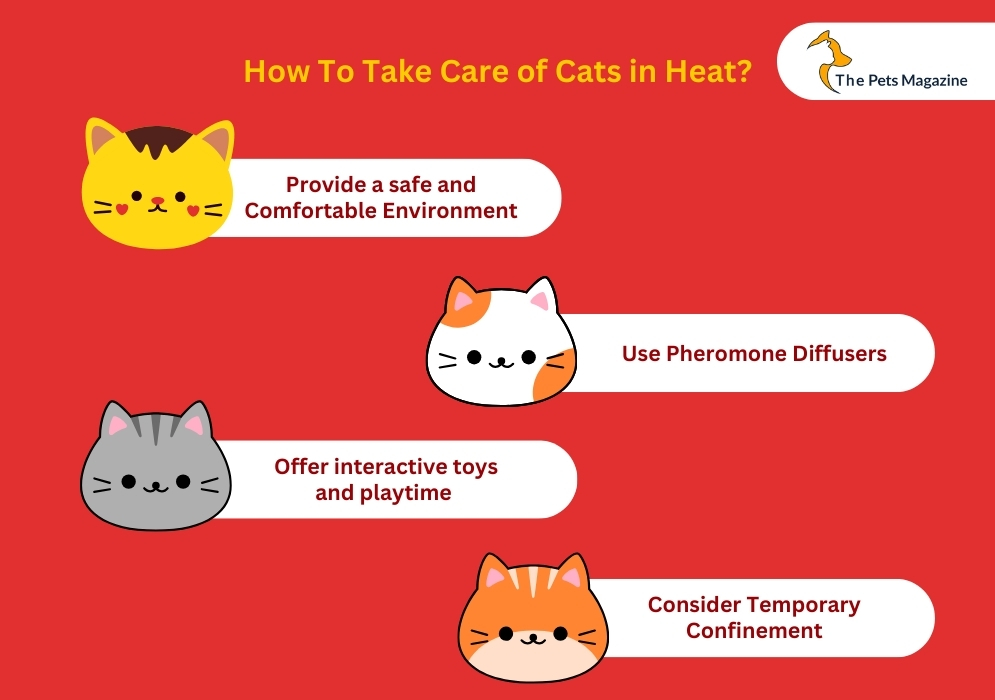
Dealing with a cat in heat can be challenging, but there are several strategies you can employ to make the experience more manageable for both you and your feline friend:
Provide a Safe and Comfortable Environment
Create a quiet, stress-free space for your cat during her heat cycle. This may involve separating her from other household pets or limiting her access to certain areas of the home.
Use Pheromone Diffusers
Pheromone diffusers for cats can help calm and reassure your kitty, potentially reducing stress-related behaviors during her heat cycle.
Offer Interactive Toys and Playtime
Engaging your cat in interactive play sessions can help redirect her energy and provide mental stimulation during this challenging time. You can play with your cat in several ways such as food games, interactive toys and training.
Consider Temporary Confinement
Suppose your cat’s behavior becomes disruptive or problematic. In that case, you may need to temporarily confine her to a secure room or crate, ensuring she has access to food, water, and a litter box.
However, if your cat’s heat cycle is causing significant distress or if you have concerns about her behavior or health, it’s always best to consult with your veterinarian for professional advice and guidance.
Final Thoughts
We know that taking care of cats in heat can be a roller coaster ride, but armed with this article, you will be better equipped to handle those yowls, bites, and escape attempts. But you should also remember that every cat is different, so if your kitty behaves a little off script, don’t be alarmed. Just be patient and calm with her, and whatever happens, don’t yell at her or punish her. It will only stress her out more.
But if you are still unsure about how to care for cats in heat, then don’t hesitate to consult your vet. After all, they are the experts, so they can give you the best advice based on your cat’s age and health condition.







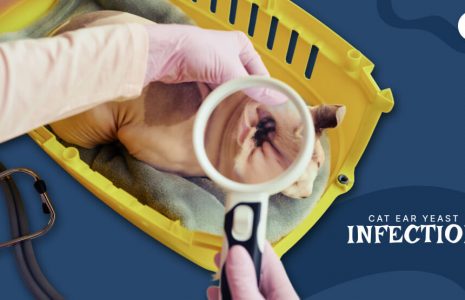

Leave A Comment